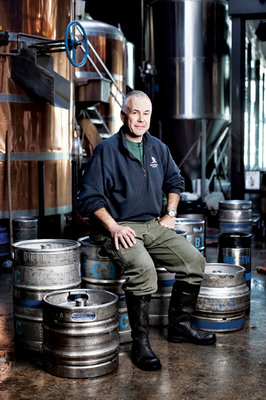When Bayonne-born Weehawkenite Mark Szmaida got the call from England asking him to help brew a special beer for English pub giant J.D. Wetherspoon in celebration of the 100-year anniversary of the sinking of the Titanic, he answered with a resounding “yes.”
Fortunately, he was not required to make the voyage by sea.
Three weeks ago, Szmaida flew to the famous Titanic Brewery in the cruise ship captain’s hometown of Stock on Trent to create a “one-off” beer based on the flagship (pun unintended) Chelsea Sunset Red Ale he makes as head brewer of Chelsea Brewing Company in midtown Manhattan. The beer, “Ship of Dreams,” debuted April 14, and is the first American collaboration J.D. Wetherspoon has organized from the New York area.
Because the beer required three weeks to brew and will only be sold by the Titanic Brewery until its 900-cask batch runs out, Szmaida hasn’t yet had the chance to taste his own historic creation.
He’s working with their people to ship him a sample – hopefully not literally.
Maiden voyage
J.D. Wetherspoon discovered Szmaida in a book dedicated to beer written by Michael Jackson, “an Englishman with a big beard who writes about whiskey and beer,” Szmaida said, not the pop star. The book featured Chelsea Brewing Company’s Titanic Barley Wine, created in 1996.
This, combined with the fact that the Titanic was set to dock at Chelsea Piers in New York City in 1912, and also that the American brewing company is the only one in the city, made Szmaida the perfect brew man for the job.
“I love going to other breweries and collaborating with people,” he said. “You always learn something; in this case it was the production of cask beer on a large scale.”
Hand-pumped casks require an older and markedly different brewing and dispensation method than drafts and kegs, Szmaida explained, and are warmer and more gently carbonated. “Ship of Dreams” was based on the Sunset Red, with a few other English touches in addition to the cask brewing.
“American beer typically has six percent alcohol,” Szmaida said, “but because the beer was made in England, it was cut to four-point-five percent.” According to the tasting notes he received from England, the reddish amber-colored ale has a nice malt profile and is highly-hopped for an English beer. It was made with American hops but with English yeast, which makes it a bit woodier than the original.
“I love going to other breweries and collaborating with people.” – Mark Szmaida
__________
Brew master sets sail
Born in Bayonne and a Weehawken resident for the past eight years, Szmaida had a decidedly non-beer-related education aside from, perhaps, drinking it. He received a degree in forestry and wildlife biology from Rutgers in 1976, and though he never used it during the following 15 years of his life as a truck mechanic and construction worker, “believe it or not, both my degree and my work as a mechanic help me at the brewery,” he said. “Brewing is chemistry, and we have to fix all of the equipment ourselves.”
Szmaida didn’t jump from mechanic to Chelsea’s head brewer overnight. He began, he explained, at home.
“I like to cook, I like to eat, I like wine, and I like beer,” he said. “Making beer is basically like making stew, so I started brewing my own at home in my thirties.”
What exactly does home brewing require? Some may conjure images of overflowing basement bathtubs bubbling with hops and barley. But it’s a much more precise and self-contained process, Szmaida explained.
There are three main elements that determine a beer’s profile: the malt, the hops, and the yeast. The only non-variable is the water, he said. He boiled crushed, malted barley in large pots five gallons at a time, which activated the enzymes and broke the starch down into sugar.
He combined the mash, or sweet liquid that rose to the top while the brew was boiled, with the hops, or the “seasoning and spice of the beer,” he said. He put this into water cooler bottles to ferment and added yeast, which ate the sugar and produced alcohol.
“You can make beer in two weeks,” Szmaida said, which is the standard time required for ales to properly ferment, versus lagers which require more time, since “lager” in German means “to store.”
“Home-brewed beer ends up being cheaper and usually ends up being better,” he added. “If you do everything right, you have control over the whole process and can produce a real quality product.”
Chelsea crosses the Hudson
Szmaida was featured in “Edible Manhattan” in January for his successes and philosophy as Chelsea Brewing Company’s head brewer for 15 years, and on April 1, the company held a launch party at Jersey City’s Barcade on Newark Avenue in celebration of the start of their first-ever New Jersey draft distribution.
Soon restaurants across the state will be able to enjoy Szmaida’s creations.
As to whether or not Szmaida continues the home-brewing tradition in Weehawken, “I just bring my beer home from work now,” he answered with a laugh.
Gennarose Pope may be reached at gpope@hudsonreporter.com.
